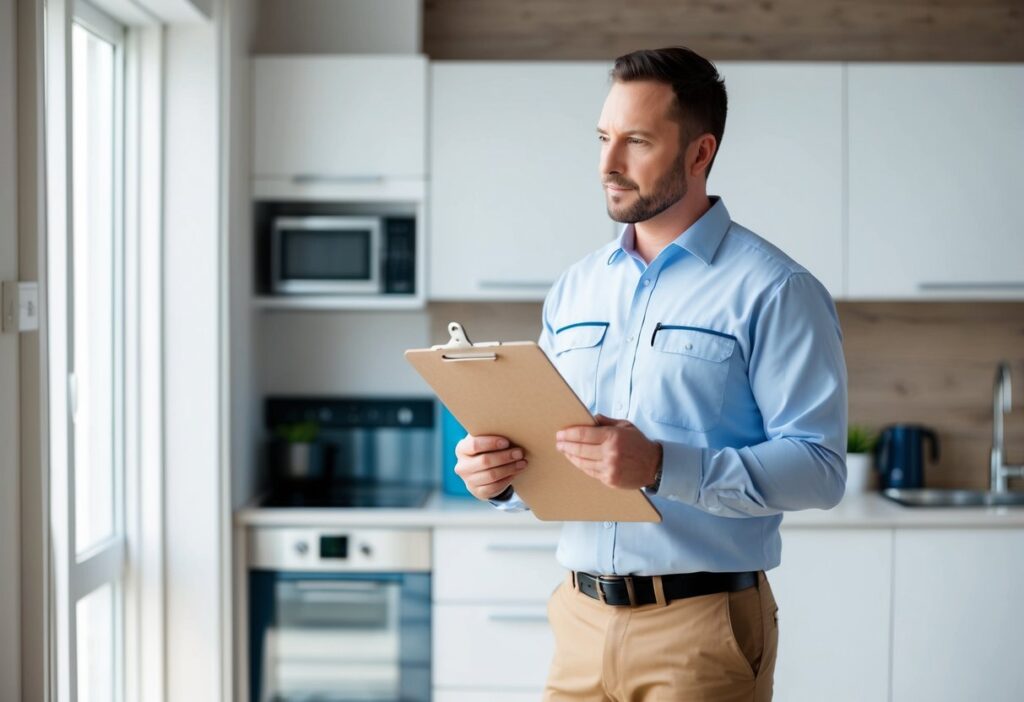Anúncios
Inspecting a rental property is a crucial step before signing any lease agreement. It helps potential tenants identify issues that could cause problems later.
Taking time to thoroughly examine a property can save renters from unexpected expenses and headaches.

A comprehensive rental property inspection checklist should include checking for water damage, testing all appliances, inspecting plumbing fixtures, examining electrical systems, and looking for signs of pest infestation. These key areas often reveal the most concerning problems that might not be immediately visible during a casual walkthrough.
Landlords sometimes try to hide serious issues or rush tenants through the viewing process. Don’t be pressured into making quick decisions without carefully examining the property.
Document any existing damage with photos and notes to protect your security deposit when it’s time to move out.
Assessing the Property’s Exterior

Inspecting a rental property’s exterior reveals crucial information about its overall condition and maintenance needs. A thorough inspection can help identify expensive problems before signing a lease.
Roof and Chimney Integrity
Look for missing, curled, or damaged shingles on the roof. These issues often indicate water damage or potential leaks.
Check for dark spots or water stains on ceilings of top floors, which suggest current leaks.
Examine chimney bricks for cracking, crumbling, or leaning. A damaged chimney is both a safety hazard and expensive to repair.
Ask about the roof’s age. Most asphalt shingle roofs last 15-25 years. If the roof is approaching the end of its lifespan, negotiate repairs or replacement before moving in.
Note any sagging areas on the roofline, as this indicates structural problems that require immediate attention from professionals.
Foundation and Drainage
Inspect the foundation walls for horizontal cracks larger than 1/4 inch, which may signal serious structural problems. Vertical hairline cracks are usually less concerning but still worth noting.
Check that the ground slopes away from the foundation. Proper grading prevents water from pooling around the building’s base.
Look for functioning gutters and downspouts that direct water at least 3 feet away from the foundation. Clogged or damaged gutters can lead to basement flooding and foundation damage.
Test basement or lower-level walls for dampness by touching them. Musty odors often indicate ongoing moisture problems that can lead to mold growth.
Windows and Doors Condition
Test all exterior doors for smooth operation. They should open and close easily without sticking or requiring excessive force.
Check window frames for rotting wood, peeling paint, or visible gaps. These issues affect energy efficiency and security.
Ensure all windows open, close, and lock properly. Sticky windows might indicate foundation shifting or frame damage.
Look for intact weatherstripping around doors and windows. Poor sealing leads to drafts and higher utility bills.
Examine glass for cracks or fogging between panes in double-glazed windows. Foggy windows have failed seals and reduced insulation value.
Landscaping and Grounds Maintenance
Identify who’s responsible for lawn care and snow removal in the lease agreement. This prevents disagreements later.
Check for dead trees or large branches that could fall and damage the property or injure someone during storms.
Examine retaining walls for leaning or bulging sections that indicate potential collapse.
Inspect walkways and driveways for major cracks, uneven sections, or potholes that present tripping hazards.
Look at fencing for stability and security. Wobbly posts or broken sections need repair before move-in.
Note the condition of irrigation systems if present. Test that sprinklers function properly and don’t spray against the building.
Evaluating the Interior Conditions

The inside of a rental property reveals critical issues that might not be apparent from the outside. A thorough interior inspection helps identify problems that could become expensive repairs or safety hazards later.
Plumbing System Efficiency
Check for water pressure by turning on multiple faucets simultaneously. Low pressure might indicate pipe problems or mineral buildup.
Look under sinks for water damage, leaks, or mold. These issues suggest ongoing plumbing problems that could worsen over time.
Flush all toilets to ensure proper operation. Listen for running water after the tank refills, which indicates a leak.
Check the water heater for rust, leaks, or strange noises. Ask about its age – most units last 8-12 years before needing replacement.
Test drain speeds in all sinks, tubs, and showers. Slow drains might indicate blockages in the plumbing system.
Red Flag Checklist:
- Water stains on ceilings or walls
- Musty smells in bathrooms or kitchen
- Visible rust on pipes
- Multiple clogged drains
- Fluctuating water temperature
Electrical Wiring and Fixtures
Test all light switches and outlets to ensure they work properly. Non-functioning outlets may indicate electrical issues.
Look for GFCI outlets in wet areas like kitchens and bathrooms. These safety features prevent electrical shocks and are required by code in newer buildings.
Examine the electrical panel for labels and organization. A messy panel with unlabeled circuits suggests poor maintenance.
Warning Signs of Electrical Problems:
- Flickering lights
- Warm outlets or switch plates
- Burning smells
- Frequently tripping breakers
- Exposed wiring
- Two-prong outlets in living areas
Check for sufficient outlets in each room. Too few outlets could lead to dangerous overuse of extension cords or power strips.
Ask about the age of wiring if the property is older than 30 years. Outdated systems like knob-and-tube or aluminum wiring pose fire risks.
Heating, Ventilation, and Air Conditioning (HVAC)
Test both heating and cooling systems regardless of season. Systems should start quickly and produce appropriate temperature air.
Replace or check air filters. Dirty filters indicate poor maintenance and can reduce system efficiency.
Listen for unusual noises when the HVAC runs. Banging, squealing, or grinding sounds suggest mechanical problems.
Check vents in each room for airflow. Blocked or closed vents can create temperature imbalances and increase energy costs.
Ask about the age of HVAC equipment and maintenance history. Most systems last 15-20 years with proper care.
Inspection Points:
- Even heating/cooling throughout rooms
- Thermostat functionality
- Condition of visible ductwork
- Evidence of regular maintenance
- Proper ventilation in bathrooms and kitchen
Walls, Floors, and Ceilings
Examine walls for cracks larger than hairline size. Significant cracks might indicate structural issues or settling problems.
Look at ceilings for water stains, sagging, or discoloration. These signs often reveal roof leaks or plumbing problems from upper floors.
Test floors for stability and evenness. Bouncy or sloping floors could indicate structural problems with joists or subflooring.
Check tile and grout in bathrooms for cracks or missing pieces. Damaged areas allow water to penetrate and cause extensive damage.
Inspect baseboards and trim for gaps, water damage, or pest activity. These areas often reveal hidden problems with moisture or insects.
Floor Inspection Points:
- Squeaking or soft spots
- Lifting or bubbling flooring materials
- Gaps between floor and baseboards
- Uneven transitions between rooms
- Water damage near exterior doors
Appliances and Fixtures
Test all included appliances for proper operation. Check refrigerator cooling, oven heating, and dishwasher functions.
Inspect washers and dryers for signs of leaking, unusual noises, or ineffective operation. Ask about age and maintenance history.
Look inside cabinets below sinks for water damage or pest evidence. These areas often reveal problems before they become visible elsewhere.
Check all faucets and fixtures for leaks, proper operation, and secure mounting. Loose fixtures indicate poor installation or maintenance.
Appliance Age Guidelines:
| Appliance | Typical Lifespan |
|---|---|
| Refrigerator | 10-13 years |
| Dishwasher | 7-10 years |
| Range/Oven | 10-15 years |
| Microwave | 5-10 years |
| Washer/Dryer | 8-12 years |
Examine bathroom fixtures like towel bars, toilet paper holders, and shower doors for stability and condition. Loose or broken fixtures suggest general neglect.
Identifying Safety Issues
Safety concerns in a rental property can affect your well-being and may indicate landlord negligence. Always inspect for working safety devices, proper security features, and signs of hazardous materials before signing any lease agreement.
Smoke and Carbon Monoxide Detectors
Properly functioning smoke and carbon monoxide detectors are essential safety features in any rental property. These devices save lives by providing early warnings of fire or dangerous gas leaks.
Detector Checklist:
- Check for smoke detectors in every bedroom and on each floor
- Verify carbon monoxide detectors are installed near sleeping areas
- Test all devices during inspection using the test button
- Check manufacturing dates (replace smoke detectors every 10 years)
- Confirm batteries work or units are hardwired
Local building codes typically require landlords to install and maintain these safety devices. If detectors are missing or non-functional, request installation before moving in. This is not a negotiable safety feature.
Security Features
A secure rental property provides peace of mind and protection for tenants and their belongings. Security features are critical indicators of a well-maintained property.
Essential Security Elements:
- Door locks should be sturdy and functional
- Deadbolts on all exterior doors
- Window locks that work properly on all windows
- Security lighting near entrances and walkways
- Clear visibility around entry points
Pay close attention to signs of forced entry or damaged locks. These could indicate previous break-ins or safety issues. Check that sliding doors have security bars and that basement windows have proper locks.
The landlord should provide new keys upon tenant changeover. If they don’t mention this, ask when locks were last changed.
Hazardous Materials Presence
Older rental properties may contain hazardous materials that pose serious health risks to tenants. Being aware of these dangers can help protect you and your family.
Common Hazardous Materials:
| Material | Where to Look | Warning Signs |
|---|---|---|
| Lead paint | Painted surfaces in pre-1978 homes | Chipping, peeling paint |
| Asbestos | Insulation, ceiling tiles, flooring | Damaged ceiling or pipe wrapping |
| Mold | Bathrooms, basements, under sinks | Musty odors, visible growth, water stains |
| Radon | Basements, ground floors | Request test results |
Ask about the property’s history with these materials. Landlords should disclose known hazards like lead paint by law. Look for water damage that could lead to mold growth.
Request documentation of any remediation work done on the property. Professional testing may be necessary if you suspect hazardous materials are present.
Understanding Legal Compliance

Navigating rental property inspections requires knowledge of legal requirements that protect both landlords and tenants. Following proper regulations helps avoid costly penalties and potential lawsuits.
Lease Agreement Adherence
Landlords must conduct inspections according to terms specified in the lease agreement. Most leases require 24-48 hours written notice before entering the property, except in emergencies.
Document all communications about inspections, including dates, times, and reasons. Keep copies of notices provided to tenants.
The lease should clearly outline:
- Frequency of inspections (quarterly, annually)
- Notice periods required before entry
- Permissible reasons for inspections
- Tenant rights during the inspection process
Violations of lease terms regarding inspections can void a landlord’s right of entry and may constitute harassment in some jurisdictions.
Local Housing Regulations
Rental properties must comply with specific local and state housing codes that vary by location.
Common regulations include:
- Habitability standards (heating, plumbing, electrical systems)
- Safety requirements (smoke detectors, carbon monoxide detectors)
- Accessibility compliance with ADA when applicable
- Lead paint disclosure for pre-1978 buildings
Many municipalities require rental licenses or periodic government inspections.
These often involve checking for health hazards like mold or pest infestations.
Landlords should maintain a checklist of local requirements and update it annually.
Staying current with changing regulations prevents violations that can result in fines ranging from hundreds to thousands of dollars.